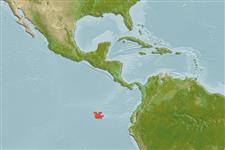>
Clupeiformes (Herrings) >
Dorosomatidae (Gizzard shads and sardinellas)
Etymology: Opisthonema: Greek, opisthe = behind + Greek,nema = filament (Ref. 45335).
Eponymy: Father Tomás de Berlanga (1487–1551) was the fourth Bishop of Panama (1534). [...] (Ref. 128868), visit book page.
Environment: milieu / climate zone / depth range / distribution range
Ecologia
marinhas; intervalo de profundidade 0 - 50 m (Ref. 188). Tropical; 3°N - 4°S, 94°W - 89°W (Ref. 188)
Southeast Pacific: endemic to the Galapagos Islands.
Tamanho / Peso / Idade
Maturity: Lm ? range ? - ? cm
Max length : 26.0 cm SL macho/indeterminado; (Ref. 188); common length : 18.0 cm SL macho/indeterminado; (Ref. 188)
Descrição suscinta
Chaves de identificação | Morfologia | Morfometria
Espinhos dorsais (total) : 0; Raios dorsais (total) : 13 - 21; Espinhos anais: 0; Raios anais : 15 - 17. The filamentous last dorsal fin ray distinguishes this species from members of any other eastern Pacific clupeoid genus. Lower gill rakers 50 to 87 in fishes over 14 cm standard length (intermediate between O. medirastre with 41 to 69 and O. libertate with 63 to 110, but neither of these occur in the Galapagos Islands).
Forms schools.
Ciclo de vida ou comportamento de acasalamento
Maturidade | Reprodução | Desova | Ovos | Fecundidade | Larvas
Whitehead, P.J.P., 1985. FAO Species Catalogue. Vol. 7. Clupeoid fishes of the world (suborder Clupeoidei). An annotated and illustrated catalogue of the herrings, sardines, pilchards, sprats, shads, anchovies and wolf-herrings. FAO Fish. Synop. 125(7/1):1-303. Rome: FAO. (Ref. 188)
Status na Lista Vermelha da UICN (Ref. 130435: Version 2024-1)
Ameaça para os humanos
Harmless
Uso pelos humanos
Pescarias: pesca de subsistência
Ferramentas
Relatórios especiais
Baixar XML
Fontes da internet
Estimates based on models
Preferred temperature (Ref.
123201): 14.5 - 23.7, mean 19.3 °C (based on 4 cells).
Índice de diversidade filogenética (Ref.
82804): PD
50 = 0.5312 [Uniqueness, from 0.5 = low to 2.0 = high].
Bayesian length-weight: a=0.00871 (0.00415 - 0.01826), b=3.06 (2.89 - 3.23), in cm total length, based on LWR estimates for this (Sub)family-body shape (Ref.
93245).
Nível Trófico (Ref.
69278): 3.3 ±0.4 se; based on size and trophs of closest relatives
Resiliência (Ref.
120179): Elevada, tempo mínimo de duplicação da população menor que 15 meses (Preliminary K or Fecundity.).
Fishing Vulnerability (Ref.
59153): Low vulnerability (22 of 100).
Nutrients (Ref.
124155): Calcium = 175 [97, 371] mg/100g; Iron = 1.71 [0.94, 3.00] mg/100g; Protein = 19.2 [18.0, 20.4] %; Omega3 = 0.442 [0.231, 0.860] g/100g; Selenium = 36.6 [17.6, 89.3] μg/100g; VitaminA = 43.8 [14.7, 136.6] μg/100g; Zinc = 1.05 [0.70, 1.62] mg/100g (wet weight);
